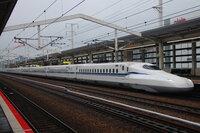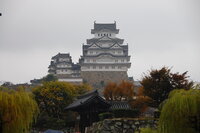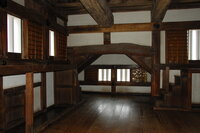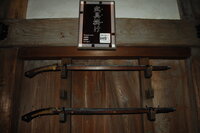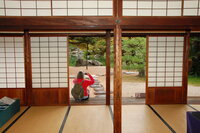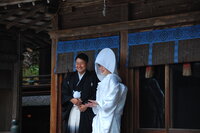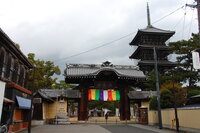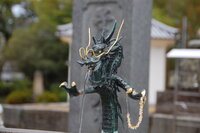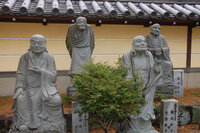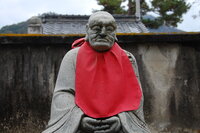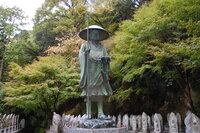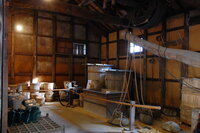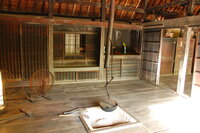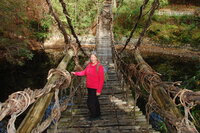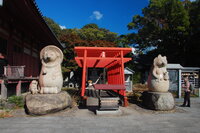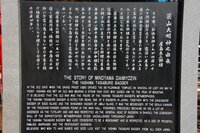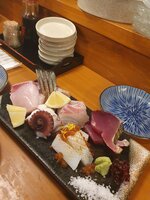The route to Takamatsu took us past Japan's best and most beautiful surviving feudal castle, so it rather felt as though we ought to stop off and take a look. This meant breaking our journey from Kyoto to Takamatsu at Himeji. The Shinkansen named Hikari 501 conveniently whisked us all the way to Himeji in 50 mins.
Himeji
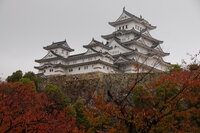
Himeji Castle sits high above the town of Himeji itself and rather dominates the place. By that we mean that, other than buying a bit of food, we didn't really interact with the town other than to walk up the main drag from the station to the castle and back. That feels like rather a shame for the town, but worked out for us as we could take in the impressive edifice and get on our way. It was doubly convenient because the heavens chose today to open. We have had a couple of dramatic night-time thunderstorms, but this was the first time we had actually been out in rain during the whole trip. At least this castle has a roof on it. The fact that there is a roof on the place and also that it is the best preserved castle in Japan are no coincidence since it was completely rebuilt from 1956. Which is OK, since it was originally constructed in 1333, although most of the existing buildings were completed in the 1600s. Whilst the castle is impressive, the visitor experience is not so great since the place is so popular. There are queues all round and one is rather herded up the inside (without shoes, of course) to the top level. Still, it was definitely worth breaking a journey for.
After visiting Himeji, we rejoined the Shinkansen for the trip down to Okayama. On this leg, we managed 188mph, which is not too shabby! It is worth noting that we are making all these rail journeys courtesy of our Japan Rail passes which we purchased before leaving the UK. Since we are travelling paupers and not rich Japanese, we are not allowed on the really fast Shinkansen called the Nozomi. However, these are only operated at up to 190mph, so we didn't feel too short-changed. After Okayama, we picked up a train called the Marine Liner that took us out over the sea to Takamatsu. It's called a "Rapid" train, but it only reaches a sedate 81mph. In other words, it should be called a "UK Rapid".
Takamatsu
Takamatsu is probably the least touristy place we will be visiting on this trip. That brings its own challenges, not least is finding something to eat. More on that later. It also means we are pretty much on our own regarding travel arrangements, etc. There is a perfectly good station here, but island trains are slow and stop at every lamp-post, so we are limited in what we can achieve in the few days were are here.
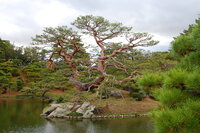
What Takamatsu does have is Ritsurin Garden which is one of the top three "strolling gardens" in Japan, so we spent a day... yep, strolling. The garden was completed in 1745 although any gardener will tell you that a garden is never completed. What we have noticed in all the gardens and parks we've visited is that the autumnal season combined with the obsessively tidy nature of the Japanese leads to an excess of leaf blowers - and this garden is no exception. The peace and quiet is marred by the incessant whirring of the infernal devices. At least, as we noted before, battery power is taking over! These strolling gardens also sport a large number of giant Bonsai trees (also known as "trees"). Not only is Ritsurin one of the finest strolling gardens in Japan, it is also one of the largest. Fortunately, there are tea houses dotted around, where we get to pay for the privilege of removing our shoes so that we can sit on the floor and drink green tea out of a bowl. On the upside, you also get a sweet to go with the tea. On the downside, that sweet is made of bean-paste. We spent most of a day in Ritsurin. Perhaps we should have strolled faster.
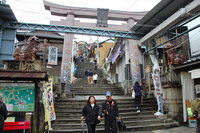
One thing that is rather surprising about the Japanese is that they are almost as bad at weather forecasting as the Brits. It really is simple: if there are no clouds, it's sunny, if there are clouds, it is raining! This lack of prescience in the weather department is unfortunate, because we planned to visit the Kompirasan Temple at Kotahira. Since the approach to this temple is up 1368 stone steps, we thought it wise to keep this visit for a cloudy day when it would not be too hot. It was pretty cool on the day we chose. It was also biblically persisting down! Nevertheless, we climbed the steps. The Lonely Planet helpfully points out that, whilst 1368 might sound like a lot, you don't make it this far into rural Japan without having climbed your fair share of steps. Indeed, it did not turn out to be too much of a drama, but the crowds (all locals) did thin out at some of the intermediate temples and not many made it to the summit. The builders must have felt the same way because the temples got smaller as we got higher, with the final one being pretty unimpressive. Still, we made it! Megan had promised that there was a submarine at the top of the mountain and, whilst this seemed rather unlikely, the fact that it Shinto'd it down all the way up meant that a capable aquatic craft located at the summit would have been understandable and welcome.
We did not discover the promised submarine. However, this is a shrine dedicated to mariners and we did spot quite a number of maritime artifacts along the route, so it is possible that a submersible was secreted somewhere amongst the temples. The fact that we did not find it is kind of the point with submarines anyway.
On the way back down, we witnessed a Shinto wedding. Steve would like to point out that, even though it rained on the happy couple's day, this was in no way, shape or form "ironic".
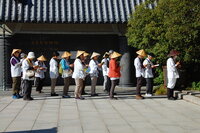
In addition to Kotahira, since we were riding a really local train, we stopped off at Zentsu-ji
to give the BUddhists some money look at another temple. This one was rather
interesting as it was more like a Buddhist theme park. You could have a go on the big bell
(donations welcome), grope around in a darkened passageway looking for enlightenment (small fee),
visit the pagoda (admission charge). This temple is also interesting because it is where Kōbō Daishi
was born. This dude founded the esoteric Shingon school of Japanese Buddhism, so he's a bit of a big
deal. Takamatsu is on Shikoku Island and that is home to a Shingon pilgrimage that circumnavigates
the island as it visits 88 temples over the course of 750 miles. Whilst Zentsu-ji is number 75 on
this pilgrimage. it is also the largest. The pilgrims are called Henro and they often wear a white
smock and a straw hat. We saw quite a few on our travels. It is not mandatory to walk the entire 750
miles (or even any of it) apparently. It is sufficient to simply visit the temples, even if by car.
It is not even obligatory to visit the temples in numerical order, which does offend Steve's
sensibilities somewhat!
We were probably as fed up with climbing steps to visit temples as you are reading about it, so we found one that had its own funicular railway. Yakuri-ji is yet another Buddhist temple, but without an entry fee, which leads one to believe they have a hand in operating the little train that takes one up the mountain. Without wishing to be trainist, this is one funny looking little vehicle and it plays some plaintive music that sounds like it was recorded in the 1940s as it hauls one up the side of the mountain. It was cold and wet up on the mountain and, for the first time, we bought a hot coffee from a vending machine. It wasn't particularly hot, but neither was it completely offensive. In addition to Yakuri-ji, we also found Yashima, which has a slope instead of steps. It is well off the beaten track and unusually, many of the local pilgrims stopped to talk to us. Yashima also seemed to deify the badger which is equally unusual. Turns out the badger is god of the restaurant trade. Who knew?
A local food speciality here is the Udon noodle and everyone raves about them. We did try them and can categorically state that a noodle is a noddle. End of. We did eat some rather good sashimi though. We've not said much about food on this trip - which is probably for the best. We might put something together later. Previously, on these blogs, we've also made some penetrating and insightful (and sometimes pithy) observations about the locals. However, times change and this is probably no longer considered acceptable. One thing that is worth saying is that, if you ever find yourself being approached by a large, yabbering group of Japanese who just plough right through you as if you're not there - that'll be the Chinese tourists.
That's pretty much it for Takamatsu. Whilst the "little train that could" was a welcome diversion, we are back on the big-boy's train next as we pick up the Shinkansen again headed for Hiroshima.
Some Pictures
